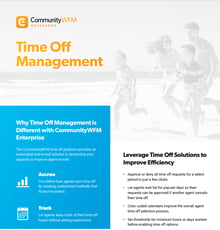
Automation may still be a buzzword in the technology industry, but it’s also a powerful way for call centers to improve their efficiency. For example, if you’re working in Excel, you may be able to automatically calculate a basic agent schedule. However, WFM software enables an entirely new set of automation options for a call center. Below are few of the main ways WFM software impacts call center automation solutions and strategies.
It’s the backbone for forecasting and scheduling automation – Simply put, call center WFM software brings automation in forecasting and scheduling to an entire new level. The technology can quickly draw upon months of historical information to create an accurate forecast based on the unique skills of your available agent workforce. The creation of schedules can even be driven by the agents themselves through an automated shift bidding process with multiple rounds. This solution is also a great way to incentivize agents who had high feedback scores last month by allowing them to be in the first bid group. Being able to place bids first means they are likely guaranteed to get their preferred shifts the next time a schedule is made.
Make the right intraday changes quickly – Automating your forecasting and scheduling can sometimes be only half the battle. Most days a call center schedule needs to account for agent delays or unexpected absences. WFM software leverages automation when this happens so a WFM admin isn’t starting from scratch trying to find replacement agents. Through automated schedule adjustment plans (ASAP) it only takes a few minutes to send out a mobile notification to all eligible agents that a shift is available. It’s a great way to save time and communicate with multiple agents through a single click.
Automation can instantly monitor agent check-ins and states – Having to manually monitor when agents are working and what they are doing is a time-consuming process. It’s why more call centers are utilizing an automated schedule attendance monitor (ASAM) within their WFM software to automate the agent check-in experience. With this technology, a WFM admin can see instantly which agents have arrived for work and their current work status. Automation can also be used to see in real-time which agents are on break or in training to avoid a large number of agents being away from their normal job responsibilities at the same time.
It streamlines the time off process – One of the latest ways automated WFM software is leveraged by call centers relates to time off management. Gone are the days of trading emails with a supervisor to see which days are available and if they can get the days off. Instead, WFM software has a color-coded calendar for agents to interact with that automatically states the likelihood of getting a time off request approved before it’s submitted. Solutions like time off bidding also exist and can be implemented within a call center to ensure a fair and balanced approach to time off requests.
To summarize, WFM software enables opportunities to automate, simplify, and streamline basic call center operations. The features available in this technology can make life easier within a call center when it comes to forecasting, scheduling, adherence, time off management, and much more.








